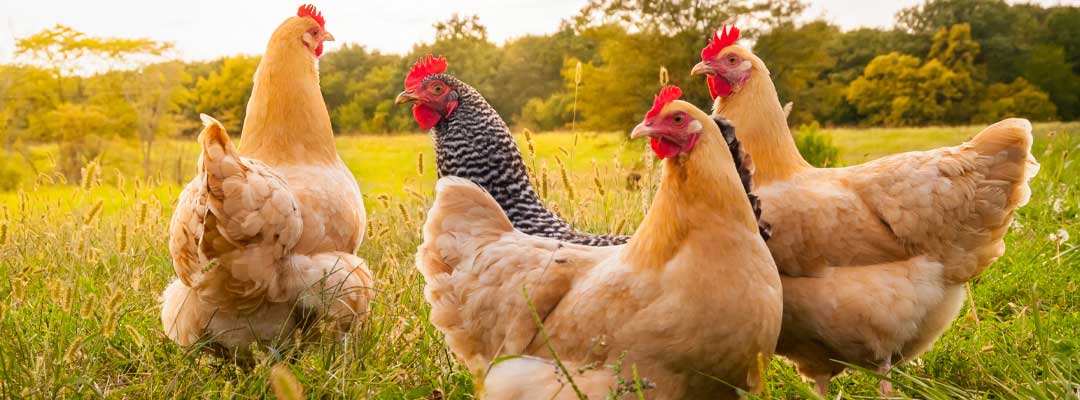Raising Chickens 101: The Basics for Managing your Brood
Learn about the necessary supplies for raising chickens, the best chickens to raise and advice on poultry health in this how-to guide on raising chickens for beginners.

Who doesn’t love incredible, edible farm fresh eggs? Raising chickens is a common practice, and it’s becoming all the more popular. Are you interested in raising chickens for eggs? If so, take a gander at these chicken-raising basics to make sure you’re prepared for what lays ahead.
Raising Chickens: Tips for Getting Started
- Check the rulebook. Step No. 1, according to The Farmer’s Almanac, a go-to source since 1818, is that you research your town or city ordinances to know whether chicken raising is allowed. You wouldn’t want to ruffle any feathers! If you’re in a more country-like setting, it’s unlikely you’ll have ordinances to follow, but it’s best to ask around just in case.
- Make the space. Ensure you have the space chickens will need. Experts recommend at least 3 square feet of floor space inside the coop and at least 8 square feet outdoors per chicken. Coops should be large enough to house their chicken feeder and water, roosting area and nesting box. Additionally, it should be large and tall enough so they can be comfortable with enough space and also, so you can easily hop in to gather eggs from their nesting box and clean their coop.
- Order supplies for raising chickens. Make a list, and check it twice. You’ll need to regularly purchase chicken feed (likely monthly), a cushy chicken coop and a nesting box for every three hens. You may also want to treat your chickens to a treat or a specially developed supplement for chickens, such as crushed oyster shell, which gives your birds a good source of calcium to help them build stronger eggshells. You’ll also need an egg basket to conveniently collect your eggs and egg cartons or egg flats (or use any that you have on hand) to safely store your fresh eggs. Check out the poultry equipment available with quick shipping from veterinarian-owned Valley Vet Supply.
- Find the time. You’ll need to allot some time for coop-cleaning responsibilities at least weekly, and feeding and watering at least once daily. Hens lay eggs year-round except sometimes during the winter months, so you should factor in time to gather eggs at least once, maybe twice, daily.
- Select your chicken breed. While there are many chicken breeds (some sources say as many as 500 breeds around the world), here are some of the most highly regarded, egg-laying chicken breeds.
- White leghorns
- Rhode Island Red
- Ameraucana
- Barred Plymouth Rock
- Speckled Sussex
- Golden Laced Wyandottes
- New Hampshire Red
- Buff Orpington
- Prioritize chicken care. Like all species, your chickens may also be up against specific health threats. Be armed with information about some of the most common illnesses in chickens, should you spot a sickly chick in your coop. And always ensure your chickens have a safe haven away from predators that may be out to get them or their eggs.
Raising Chickens: Understanding Poultry Health Risks
Some of the most common poultry health concerns include necrotic enteritis, Coccidiosis, fowl pox and Marek’s disease. Necrotic enteritis is a common bacterial disease affecting chickens. Early signs can include wet litter and diarrhea, and an increase in death. Necrotic enteritis is caused by Clostridium perfringens, which is a bacterium found in the soil, dust and litter. Help prevent and control necrotic enteritis in chickens with BMD for poultry and livestock drinking water.
Coccidiosis in chickens is most often seen in younger birds. Watch for signs like bloody and/or mucus-like diarrhea, anemia, dehydration, ruffled feathers, slow growth, decreased egg production and death. You can help prevent the disease by using a medicated starter feed; Advent Coccidiosis vaccine for chickens is a vaccine that prevents coccidiosis. And should your chickens be diagnosed with Coccidiosis, you can treat your flock using AmproMed-P amprolium solution.
Fowl pox is a highly contagious viral infection in poultry, causing painful sores that you may find on their skin in non-feathered areas like the comb, face and eyelid. The virus is transmitted by biting insects, like the mosquito. Fowl pox impact’s a bird’s upper respiratory system, as well as their eyes, mouth and throat. Watch for signs like decreased egg production, loss of appetite and weight loss, and lesions on their skin, inside their mouth or throat. Administering a fowl pox vaccine for chickens is critical to prevent this potentially life-threatening virus, as well as controlling mosquitoes.
Marek’s disease , also known as MD, is a herpes infection impacting chickens. There are many clinical signs of disease to keep watch for, including: weight loss, paralysis in legs, wings and neck, irregular pupil and grey iris, impaired vision, and roughened skin surrounding feather follicles. Vaccination is key for the prevention of this devastating disease, so when purchasing chicks make sure the hatchery has vaccinated them. If you decide to try your hand at hatching your own chicks, vaccinate your healthy one-day-old chicks with MD-Vac CFL to aid in the prevention of the signs and lesions of Marek’s disease.
Additionally, nothing is more important to the overall health of your flock than clean, clear water, which is essential for poultry health. Contaminated water is a serious threat. Manna Pro water protector provides a unique blend of enzymes that stop film, residue and natural contaminants from affecting the taste and quality of your poultry's water.
Valley Vet Supply was founded in 1985 by veterinarians for people just like you, people who want the very best for their animals, large or small. Continue learning and shopping for your backyard chickens.


